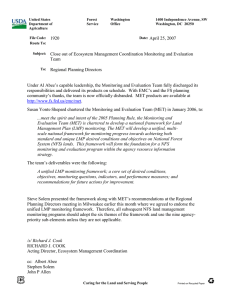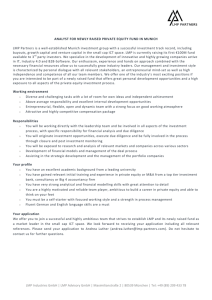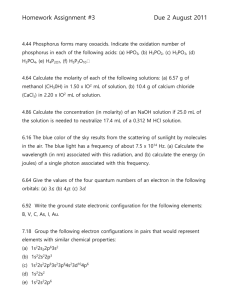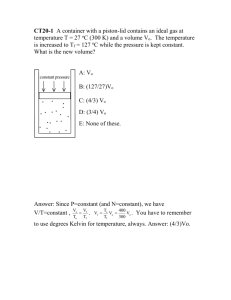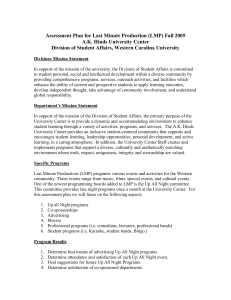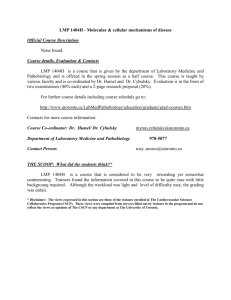Ecosystem Management Coordination (EMC) Monitoring and Evaluation Framework’s Contribution to
advertisement
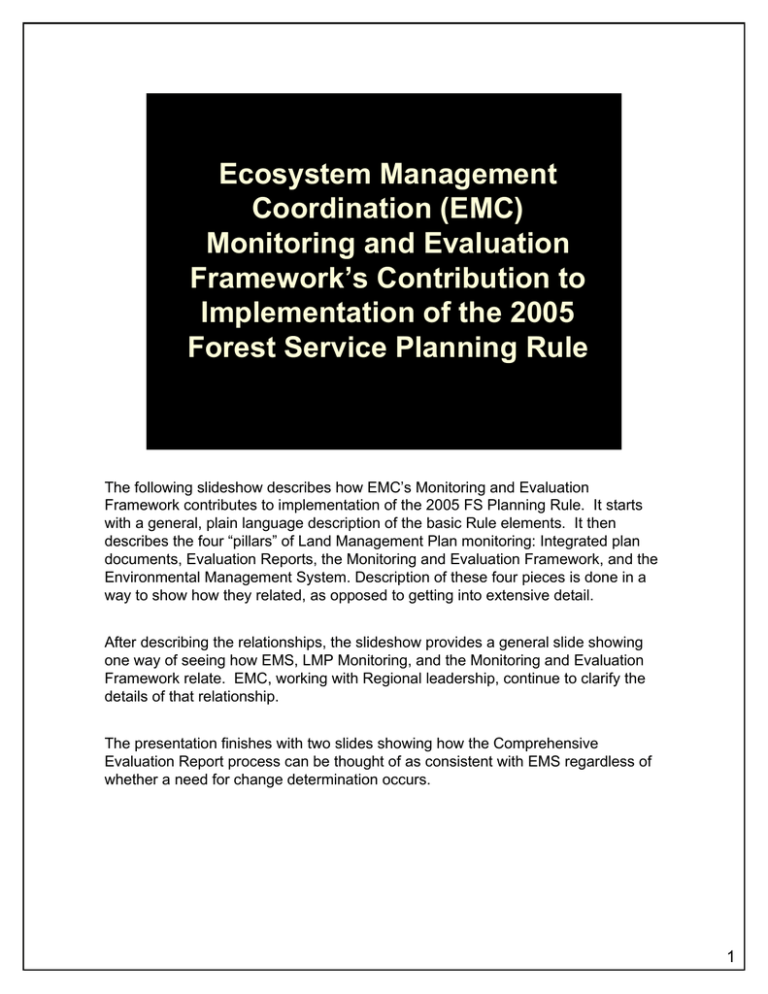
Ecosystem Management Coordination (EMC) Monitoring and Evaluation Framework’s Contribution to Implementation of the 2005 Forest Service Planning Rule The following slideshow describes how EMC’s Monitoring and Evaluation Framework contributes to implementation of the 2005 FS Planning Rule. It starts with a general, plain language description of the basic Rule elements. It then describes the four “pillars” of Land Management Plan monitoring: Integrated plan documents, Evaluation Reports, the Monitoring and Evaluation Framework, and the Environmental Management System. Description of these four pieces is done in a way to show how they related, as opposed to getting into extensive detail. After describing the relationships, the slideshow provides a general slide showing one way of seeing how EMS, LMP Monitoring, and the Monitoring and Evaluation Framework relate. EMC, working with Regional leadership, continue to clarify the details of that relationship. The presentation finishes with two slides showing how the Comprehensive Evaluation Report process can be thought of as consistent with EMS regardless of whether a need for change determination occurs. 1 The 2005 Rule as a System: Quick, Specific References Rule Reference Plain Language • 219.3: Nature of Planning What we’re trying to do • 219.4: NEPA Compliance & 219.5: Environmental Mgmt. Systems (EMS) How we’ll ensure accountability How we’ll know we need to change • 219.6: Evaluations and Monitoring (Soc, Econ, Ecol) • 219.7: Developing, Amending, or Revising • 219.9: Public Participation, Collaboration, & Notification • 219.10: Sustainability • 219.11: Role of Science How we’ll make changes How we’ll approach discussions How we’ll focus discussions How we’ll ground our discussions One way of understanding the Rule in an integrated way is to focus on the plain language topics that each section of the Rule addresses. 2 The 2005 Rule as a System: 4 Keys to LMP Monitoring 1. LMP Plan Components 2. LMP Monitoring Program 3. LMP Evaluation Reports 4. EMS How the NFS Monitoring and Evaluation Framework Helps these Keys Fit Together … 3 LMP Monitoring Keys #1 And #2 For the purposes of this discussion, an LMP has two principle plan “documents” that must be integrated: LMP components and the LMP Monitoring Program. There are other documents that can or should go into the Plan Set of Documents, including Evaluation Reports and EMS components, but these first two documents are a good starting point. 4 There are four general questions that an LMP Monitoring Program must have the capacity to address: effectiveness, implementation, progress, and change management. 5 LMP Monitoring “Key” #3 Evaluations are a key part of an LMP’s adaptive planning process. There are three types of evaluation: annual monitoring reports, comprehensive evaluation reports, and evaluations done for LMP amendment purposes. Annual monitoring reports look at monitoring results from the previous year as they compare to the LMP monitoring program questions. It is important to note that an annual monitoring report does not necessarily have to contain information on the same topics every year. If, for example, a topic is only monitoring every third year, only every third monitoring report would contain reference. In other words, it isn’t necessary to design an annual monitoring report around only those indicators that you would want to report every year. This has been a point of confusion. 6 LMP Monitoring “Key” #4 The basic Environmental Management System process is also a central component of LMP efforts. We’ve used the four generic phases of an EMS cycle to explain how the Monitoring and Evaluation Framework fits with the other key pieces. For example, the Monitoring and Evaluation Framework results from ‘planning’ for an LMP Monitoring Program that anticipates the needs for LMP evaluations. 7 LMP Monitoring “Framework” that helps integrate the “4 Keys” The Monitoring and Evaluation Framework (a.k.a., the MET) has been designed to meet evaluation needs in an integrated way. Three ecological themes, each with associated sub-elements, are part of the framework. 8 The Monitoring and Evaluation Framework (a.k.a., the MET) has been designed to meet evaluation needs in an integrated way. Three ecological themes, each with associated sub-elements, are part of the framework. 9 The basic Environmental Management System process is also a central component of LMP efforts. We’ve used the four generic phases of an EMS cycle to explain how the Monitoring and Evaluation Framework fits with the other key pieces. For example, the Monitoring and Evaluation Framework results from ‘planning’ for an LMP Monitoring Program that anticipates the needs for LMP evaluations. 10 Each framework Theme speaks to LMP Monitoring Program needs and LMP Evaluation needs. 11 The ‘Do’ phase of an EMS cycle is reflected in the details of the framework. In this example, the critical content of the framework had to focus on two principle LMP components—Desired Conditions and Objectives—and on the four key questions that an LMP Monitoring Program must address. Accordingly, the Monitoring and Evaluation Framework is deliberately focused on LMP Components and the LMP Monitoring Program. 12 The ‘Check’ phase of an EMS cycle is where the learning occurs. During an LMP process, the ‘check’ phase must focus on the four key monitoring questions. The overarching question here is simply whether there is a need for change. Anticipating the eventual need to identify or propose actual changes is helpful, but not essential because that is a larger question. Here, the question is just whether there are indications of a need for change, not what the actual change should be. 13 The ‘Act’ phase of an EMS cycle is where viable changes are actually identified. For example, the two primary targets of change are the LMP and the LMP Monitoring Program. In this example, though, the Monitoring and Evaluation Framework might deserve change based on learning captured through evaluations. From this point, a new EMS cycle could begin, starting with planning of actual changes. So, if evaluations show ‘Check’ results that suggest a ‘need for change’, the ‘Act’ phase of an EMS could suggest which changes are especially viable and the subsequent ‘Plan’ phase would focus on developing an appropriate level of detail regarding those changes. There are other ways one could look at all this, some more complicated than others. This is just one broad-scale application that addresses high-level connections. 14 Crosswalk: How the NFS M&E Framework facilitates integration of EMS and LMP Components 15 Cross-Walk of: 1. EMS 2. NFS M&E Framework 3. LMP Components Area of “Overlap” Only (Items are functionally similar, but not necessarily equivalent) 16 Comprehensive Evaluation Reports: The Hub of LMP Process How The 4 Keys of LMP Monitoring Come Together For Adaptive Management 17 18 19 Discussion 20
